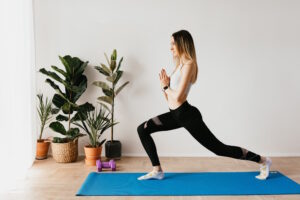
Pilates is a highly effective exercise system renowned for its ability to promote better posture, among other numerous benefits. In this comprehensive guide, we will explore how Pilates can be a valuable tool for improving posture and maintaining a healthy alignment of the body. We’ll delve into its potential to address bad posture, the timeline for seeing improvements, its role in addressing issues like hunchback, and how it compares to yoga in terms of posture improvement.
Can Pilates fix bad posture?
Yes, Pilates can be incredibly effective in addressing and improving bad posture. Poor posture often results from imbalances in muscle strength and flexibility, along with habits that lead to muscle tightness and weakness. Pilates offers a holistic approach to posture improvement by addressing these underlying factors:
Core Strengthening: Pilates places a strong emphasis on core strengthening, particularly the deep core muscles that support the spine. A strong core provides the stability needed to maintain an upright posture.
Muscle Imbalances: Pilates exercises are designed to correct muscle imbalances by targeting both the larger, superficial muscles and the smaller, stabilizing muscles. This helps bring the body into better alignment.
Flexibility and Mobility: Pilates incorporates a wide range of exercises that promote flexibility and joint mobility. Increased flexibility allows for a more natural and comfortable posture.
Mindful Movement: Pilates encourages body awareness and mindfulness in movement. Practitioners learn to recognize and correct poor postural habits, such as slouching or rounding the shoulders.
Postural Awareness: Pilates instructors often provide cues and feedback to help participants maintain proper alignment during exercises, which carries over into everyday life.
While Pilates can significantly improve bad posture, it’s essential to maintain consistency in your practice to see long-term benefits.
How long does it take for Pilates to improve posture?
The timeline for seeing improvements in posture through Pilates varies from person to person and depends on several factors:
1. Current Postural Condition: The severity of your bad posture and any underlying issues will influence how long it takes to see improvements. Mild posture issues may show progress more quickly than severe ones.
2. Consistency: Regular and consistent Pilates practice is essential for noticeable improvements. Practicing 2-3 times a week can yield results more quickly than sporadic sessions.
3. Individual Factors: Your individual body, including factors like age, genetics, and previous injuries, can impact the timeline for improvements.
4. Instructor Guidance: Working with a qualified Pilates instructor who specializes in posture improvement can expedite the process by providing personalized guidance and exercises.
As a general guideline, many individuals report feeling and seeing improvements in their posture within a few weeks to a few months of consistent Pilates practice. However, for lasting results and to maintain a healthy posture, it’s advisable to make Pilates a part of your long-term fitness routine.
Can Pilates fix hunchback?
Pilates can be beneficial for addressing issues related to hunchback, also known as kyphosis. Kyphosis is characterized by an exaggerated rounding of the upper back, often leading to a hunched posture. Pilates exercises can help in the following ways:
1. Strengthening the Upper Back: Pilates includes exercises that target the muscles of the upper back and shoulders, helping to strengthen and tone these areas.
2. Stretching Tight Muscles: Pilates incorporates stretches and movements that help open up the chest and alleviate tightness in the muscles of the chest and shoulders, which can contribute to hunchback posture.
3. Core Strengthening: A strong core is essential for maintaining an upright posture. Pilates helps strengthen the core muscles, providing support for the spine and upper body.
4. Spinal Alignment: Pilates exercises promote better spinal alignment, which can gradually improve the posture of individuals with kyphosis.
It’s important to note that addressing kyphosis with Pilates may require consistent practice over an extended period. Individuals with severe kyphosis or underlying medical conditions should consult with a healthcare provider or physical therapist before beginning any exercise program.
Is yoga or Pilates better for posture?
Both yoga and Pilates can be effective for improving posture, but they offer slightly different approaches and benefits:
Yoga for Posture Improvement:
· Focus on Flexibility: Yoga places a strong emphasis on stretching and lengthening the muscles, which can improve flexibility and alignment.
· Mind-Body Connection: Yoga incorporates mindfulness and breath awareness, helping individuals become more attuned to their bodies and posture.
· Variety of Styles: Various styles of yoga, such as Iyengar and Hatha, specifically target posture improvement with a focus on alignment.
Pilates for Posture Improvement:
· Core Strengthening: Pilates is renowned for core strengthening, which provides the stability needed for good posture.
· Muscle Balance: Pilates exercises target both larger and smaller muscle groups, addressing muscle imbalances that contribute to poor posture.
· Specific Exercises: Pilates includes specific exercises designed to correct common postural issues, such as rounded shoulders or forward head posture.
The choice between yoga and Pilates for posture improvement may depend on personal preference and individual needs. Some individuals find that combining elements of both practices can be particularly effective for achieving and maintaining good posture. Ultimately, the most suitable approach is the one that resonates with you and encourages consistent practice.
In conclusion, Pilates is a highly effective tool for improving posture by addressing muscle imbalances, promoting core strength, and cultivating mindfulness in movement. It can be effective in addressing bad posture and issues like hunchback, but the timeline for improvements varies among individuals. Whether you choose Pilates, yoga, or a combination of both, consistency and a commitment to healthy posture are key to experiencing lasting benefits.